News
New event-averaging method to map catalyst structure and local gas environment simultaneously enables depiction of transitional active surface structures

One of the key challenges in catalysis research is to understand how catalysts’ structure and function relate to each other. Regardless of the type of catalyst in question, structure and function are dynamic with a strong dependence on the localized reaction conditions such as temperature, pressure, and gas composition just above the catalyst surface. Now, researchers developed a new event-averaging-based method employing time-resolved ambient pressure photoelectron spectroscopy to map catalyst structure and local gas environment simultaneously while reaction conditions are changed rapidly. With this new method, scientists can determine in detail what triggers structural changes on the sample surface and even measure the activity during a structural transition. This enables scientists to examine active surface structures with ambient pressure photoelectron spectroscopy that only exists for sub-second time-scale during rapid transitional stages while running a chemical reaction. The publication was even featured in Nature Communications’ Editors’ Highlights webpage of recent research related to “catalysis.”
MEMO's Nanocar Race II @ C’NANO Conference

We are delighted to highlight that the C´NANO Conference 2021 will take place in Toulouse, France from 23rd to 25th November 2021. The conference begins with a MEMO satellite workshop entitled “Single molecule mechanics on a surface: gears, motors and cars”. On 23 November 2021, 6 pm all the 8 Nanocar Race II teams officially registered will present their first molecule-car prototype to the public. We are happy to support this annual event, many of the teams are running the experiments and the race on SPMs from Scienta Omicron.
Momentum Microscopy at Work

Scientists of the University of Graz succeeded in visualising the electronic structure of long-chain organic semiconductors and altering it by means of temperature effects in a controlled manner. More specifically, they demonstrated that monolayers of heptacene on Cu(110) behave markedly different compared to all previously studied oligoacene monolayers on coinage metal surfaces and are dissimilar to any other polycyclic aromatic hydrocarbons adsorbed on metal substrates studied so far. Photoemission tomography measurements were performed using the NanoESCA system and the STM and LEED measurements were performed in a two-chamber system with a variable-temperature Scanning Tunnelling Microscopy (VT STM) both from Scienta Omicron.
Scienta omicron Newsflyer Fall 2021
Welcome to the Scienta Omicron Newsflyer for Fall 2021. 40 years ago in 1981, our co-founder Prof. Kai Siegbahn was awarded the Nobel Prize in Physics for developing the method of Electron Spectroscopy for chemical analysis (ESCA/XPS) – thereby creating the starting point for Scienta. Since then, the technology has been extended to incorporate Molecular Beam Epitaxy, Thin Film Deposition, Scanning Probe Microscopy Systems and a wide range of components. Keeping our tradition of pioneering and leading Surface Science and Nanotechnology innovation, Scienta Omicron is excited to release the revolutionary DFS30 analyser – a ground-breaking and patent pending Electrostatic 3D Focus Adjustment technology. We are also launching our new CREATE Platform – a configurable platform delivering your unique UHV Systems.
